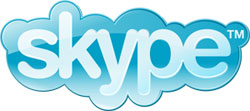With more 1 million mobile phone customers and more than 700,000 registered users of the social networking Web site draugiem.lv, Latvia has never been far behind the rest of Europe in the take up of new technologies. People in Latvia also are big users of Skype, a service that allows you to place voice calls using the Internet at a fraction of typical call rates.
Although Internet telephony software has been around for nearly a decade, it took two Scandinavian entrepreneurs and four Estonian programmers with their already proven file sharing technology to overcome previous technical hurdles and offer Skype. It is a simple and very affordable service now being used by 120 million people worldwide.
Skype has made such an impact that it now carries 7 percent of worldwide telephony traffic. Major telephone companies around the world are beginning to realise that the days of cashing in on long distance calls are well and truly over. In October 2005, after only two years since its inception, Skype was acquired by eBay for a mere USD 4 billion. Skype’s main operations centre is located in Tallinn and it has recently recruited a programmer from Latvia as well.
So what is the big fuss all about? With a reasonably fast Internet connection (broadband is recommended) and a Windows-, Macintosh- or Linux-based computer, you can be up and running within minutes. The free downloadable Skype client software has evolved to become an impressive communications suite with phone and video conferencing, instant messaging, voicemail and the ability to connect to any standard telephone service (SkypeOut) for as low as EUR 0.017 per minute. But the main reason for its popularity is that you can talk to any other Skype user on the planet for free—provided that they are also connected to the Internet and Skype is running on the other computer. Skype is also platform agnostic, which means you can voice or video call irregardless of whether the other user is running Windows or Macintosh. With the new Skype handsets it is possible to bypass the computer altogether—you can place calls anywhere where you can find a wireless Internet connection.
Skype has acknowledged its popularity in Latvia by providing a Latvian version of its Web site. It also plans to provide a Latvian interface in a future release of the client software.
The disparate pricing for SkypeOut rates to and from Latvia is due to the highly regulated communications environment that still exists in Latvia. If you are located in Rīga, a call to a regular Australian or U.S. telephone number is only EUR 0.017 per minute, but in the reverse direction it climbs to as high as EUR 0.122 per minute for calls to Latvian mobiles. For this reason the most popular way to use Skype remains from computer to computer and it is, of course, free.
Not to be left out Lattelecom recently launched a new home communications package for a monthly charge of LVL 13.90 that includes 2Mbps of broadband Internet access and free local calls. Expect similar deals from other major telcos to emerge in the near future as well.
I have been using Skype for over a year—mainly from Australia and recently in our travels ranging from a remote country house in north Vidzeme, Frankfurt airport, the Atbalsis retreat in Gaŗezers, a busy youth hostel in downtown Helsinki to the WiFi-enabled Vērmaņdārzs in Rīga. The quality of the voice conversations has been as good if not better than the ordinary telephone service. For best results plug in a computer headset to avoid voice echo effects and invest in a Webcam so you can beam your smile to your friends as well.
What are the drawbacks? Skype is only as good as your Internet service provider (ISP) and the quality of service you get from it. Don’t go cancelling your landline just yet, because low-cost ISPs can’t match the reliability of the ordinary telephone service provided by the major telecommunication companies. ISPs have a tendency to have service disruptions, whereas your standard telephone handset is guaranteed to be operational even during power outages — essential for those emergency calls. But the price of Skype is hard to beat.
If you’re a Latvian business or organisation operating internationally or simply want to keep in touch with friends and relatives you can save a bundle on your long distance communication costs and get a taste of this exciting new technology.

Skype, a company started by Swedish entrepreneurs and Estonian programmers, has become the world’s most widely used Internet telephony service.



